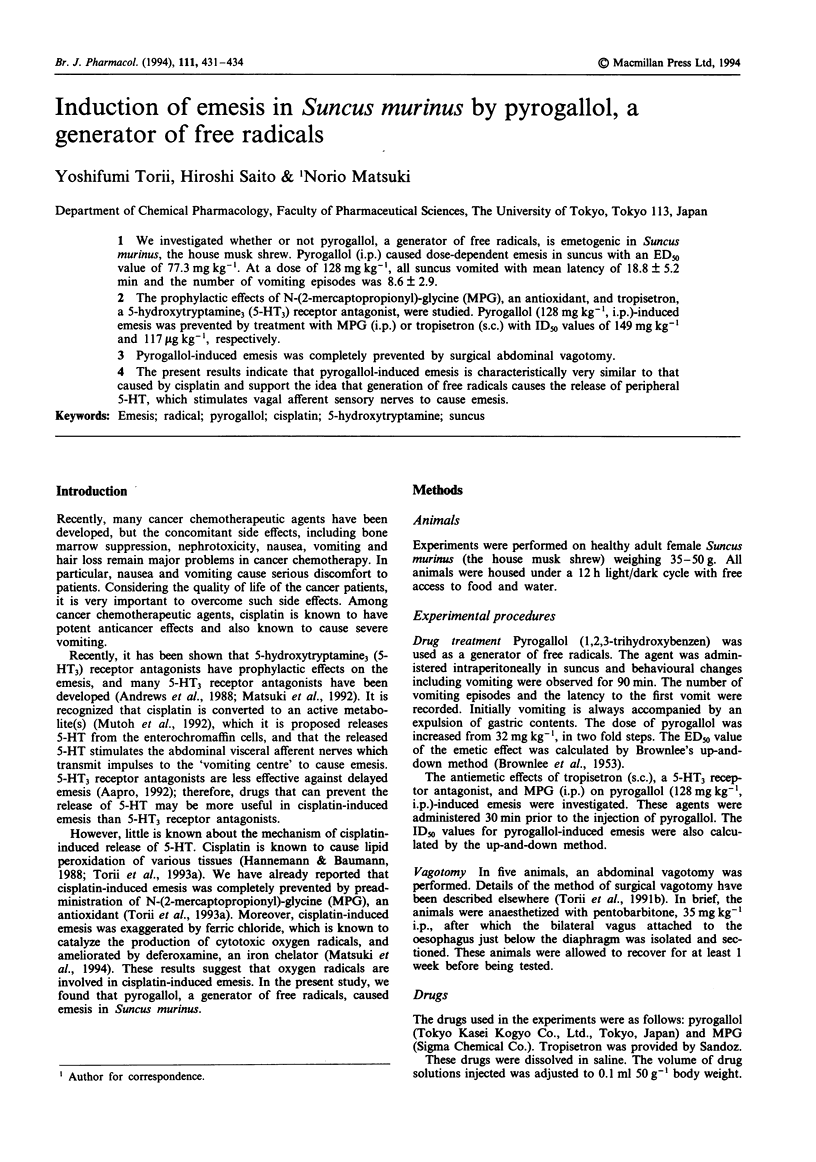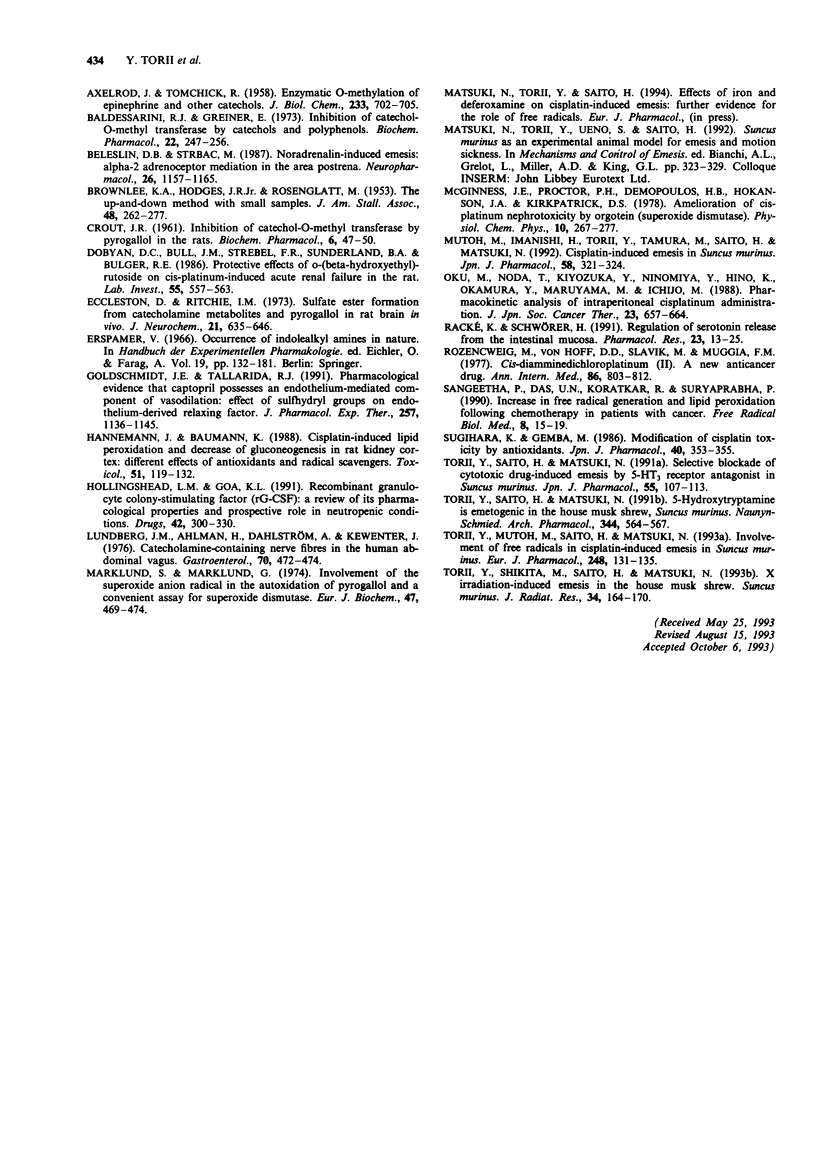Abstract
1. We investigated whether or not pyrogallol, a generator of free radicals, is emetogenic in Suncus murinus, the house musk shrew. Pyrogallol (i.p.) caused dose-dependent emesis in suncus with an ED50 value of 77.3 mg kg-1. At a dose of 128 mg kg-1, all suncus vomited with mean latency of 18.8 +/- 5.2 min and the number of vomiting episodes was 8.6 +/- 2.9. 2. The prophylactic effects of N-(2-mercaptopropionyl)-glycine (MPG), an antioxidant, and tropisetron, a 5-hydroxytryptamine3 (5-HT3) receptor antagonist, were studied. Pyrogallol (128 mg kg-1, i.p.)-induced emesis was prevented by treatment with MPG (i.p.) or tropisetron (s.c.) with ID50 values of 149 mg kg-1 and 117 micrograms kg-1, respectively. 3. Pyrogallol-induced emesis was completely prevented by surgical abdominal vagotomy. 4. The present results indicate that pyrogallol-induced emesis is characteristically very similar to that caused by cisplatin and support the idea that generation of free radicals causes the release of peripheral 5-HT, which stimulates vagal afferent sensory nerves to cause emesis.
Full text
PDF



Selected References
These references are in PubMed. This may not be the complete list of references from this article.
- AXELROD J., TOMCHICK R. Enzymatic O-methylation of epinephrine and other catechols. J Biol Chem. 1958 Sep;233(3):702–705. [PubMed] [Google Scholar]
- Andrews P. L., Rapeport W. G., Sanger G. J. Neuropharmacology of emesis induced by anti-cancer therapy. Trends Pharmacol Sci. 1988 Sep;9(9):334–341. doi: 10.1016/0165-6147(88)90106-x. [DOI] [PubMed] [Google Scholar]
- Baldessarini R. J., Greiner E. Inhibition of catechol-O-methyl transferase by catechols and polyphenols. Biochem Pharmacol. 1973 Jan 15;22(2):247–256. doi: 10.1016/0006-2952(73)90277-3. [DOI] [PubMed] [Google Scholar]
- Beleslin D. B., Strbac M. Noradrenaline-induced emesis. Alpha-2 adrenoceptor mediation in the area postrema. Neuropharmacology. 1987 Aug;26(8):1157–1165. doi: 10.1016/0028-3908(87)90262-0. [DOI] [PubMed] [Google Scholar]
- CROUT J. R. Inhibition of catechol-O-methyl transferase by pyrogallol in the rat. Biochem Pharmacol. 1961 Apr;6:47–50. doi: 10.1016/0006-2952(61)90067-3. [DOI] [PubMed] [Google Scholar]
- Dobyan D. C., Bull J. M., Strebel F. R., Sunderland B. A., Bulger R. E. Protective effects of O-(beta-hydroxyethyl)-rutoside on cis-platinum-induced acute renal failure in the rat. Lab Invest. 1986 Nov;55(5):557–563. [PubMed] [Google Scholar]
- Eccleston D., Ritchie I. M. Sulphate ester formation from catecholamine metabolites and pyrogallol in rat brain in vivo. J Neurochem. 1973 Sep;21(3):635–646. doi: 10.1111/j.1471-4159.1973.tb06008.x. [DOI] [PubMed] [Google Scholar]
- Goldschmidt J. E., Tallarida R. J. Pharmacological evidence that captopril possesses an endothelium-mediated component of vasodilation: effect of sulfhydryl groups on endothelium-derived relaxing factor. J Pharmacol Exp Ther. 1991 Jun;257(3):1136–1145. [PubMed] [Google Scholar]
- Hannemann J., Baumann K. Cisplatin-induced lipid peroxidation and decrease of gluconeogenesis in rat kidney cortex: different effects of antioxidants and radical scavengers. Toxicology. 1988 Oct;51(2-3):119–132. doi: 10.1016/0300-483x(88)90143-6. [DOI] [PubMed] [Google Scholar]
- Hollingshead L. M., Goa K. L. Recombinant granulocyte colony-stimulating factor (rG-CSF). A review of its pharmacological properties and prospective role in neutropenic conditions. Drugs. 1991 Aug;42(2):300–330. doi: 10.2165/00003495-199142020-00009. [DOI] [PubMed] [Google Scholar]
- Lundberg J., Ahlman H., Dahlström A., Kewenter J. Catecholamine-containing nerve fibres in the human abdominal vagus. Gastroenterology. 1976 Mar;70(3):472–474. [PubMed] [Google Scholar]
- Marklund S., Marklund G. Involvement of the superoxide anion radical in the autoxidation of pyrogallol and a convenient assay for superoxide dismutase. Eur J Biochem. 1974 Sep 16;47(3):469–474. doi: 10.1111/j.1432-1033.1974.tb03714.x. [DOI] [PubMed] [Google Scholar]
- McGinness J. E., Proctor P. H., Demopoulos H. B., Hokanson J. A., Kirkpatrick D. S. Amelioration of cis-platinum nephrotoxicity by orgotein (superoxide dismutase). Physiol Chem Phys. 1978;10(3):267–277. [PubMed] [Google Scholar]
- Mutoh M., Imanishi H., Torii Y., Tamura M., Saito H., Matsuki N. Cisplatin-induced emesis in Suncus murinus. Jpn J Pharmacol. 1992 Mar;58(3):321–324. doi: 10.1254/jjp.58.321. [DOI] [PubMed] [Google Scholar]
- Oku M., Noda T., Kiyozuka Y., Ninomiya Y., Hino K., Okamura Y., Maruyama M., Ichijo M. [Pharmacokinetic analysis of intraperitoneal cisplatinum administration]. Nihon Gan Chiryo Gakkai Shi. 1988 Mar 20;23(3):657–664. [PubMed] [Google Scholar]
- Racké K., Schwörer H. Regulation of serotonin release from the intestinal mucosa. Pharmacol Res. 1991 Jan;23(1):13–25. doi: 10.1016/s1043-6618(05)80101-x. [DOI] [PubMed] [Google Scholar]
- Rozencweig M., von Hoff D. D., Slavik M., Muggia F. M. Cis-diamminedichloroplatinum (II). A new anticancer drug. Ann Intern Med. 1977 Jun;86(6):803–812. doi: 10.7326/0003-4819-86-6-803. [DOI] [PubMed] [Google Scholar]
- Sangeetha P., Das U. N., Koratkar R., Suryaprabha P. Increase in free radical generation and lipid peroxidation following chemotherapy in patients with cancer. Free Radic Biol Med. 1990;8(1):15–19. doi: 10.1016/0891-5849(90)90139-a. [DOI] [PubMed] [Google Scholar]
- Sugihara K., Gemba M. Modification of cisplatin toxicity by antioxidants. Jpn J Pharmacol. 1986 Feb;40(2):353–355. doi: 10.1254/jjp.40.353. [DOI] [PubMed] [Google Scholar]
- Torii Y., Mutoh M., Saito H., Matsuki N. Involvement of free radicals in cisplatin-induced emesis in Suncus murinus. Eur J Pharmacol. 1993 Aug 2;248(2):131–135. doi: 10.1016/0926-6917(93)90034-n. [DOI] [PubMed] [Google Scholar]
- Torii Y., Saito H., Matsuki N. 5-Hydroxytryptamine is emetogenic in the house musk shrew, Suncus murinus. Naunyn Schmiedebergs Arch Pharmacol. 1991 Nov;344(5):564–567. doi: 10.1007/BF00170653. [DOI] [PubMed] [Google Scholar]
- Torii Y., Saito H., Matsuki N. Selective blockade of cytotoxic drug-induced emesis by 5-HT3 receptor antagonists in Suncus murinus. Jpn J Pharmacol. 1991 Jan;55(1):107–113. doi: 10.1254/jjp.55.107. [DOI] [PubMed] [Google Scholar]
- Torii Y., Shikita M., Saito H., Matsuki N. X-irradiation-induced emesis in Suncus murinus. J Radiat Res. 1993 Jun;34(2):164–170. doi: 10.1269/jrr.34.164. [DOI] [PubMed] [Google Scholar]


